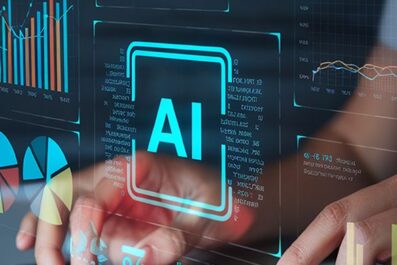How AI Turns Data into Smarter Business Decisions
Companies using AI for decision-making see 25% higher profits.
 5 Min
5 Min 
But as we look ahead to 2025, the question remains: how does raw data transform into actionable wisdom? In today’s rapidly evolving business landscape, organizations are drowning in information while starving for insights. Traditional manual analysis can’t keep pace with the increasing volume and velocity of data, leading to delayed decisions, missed opportunities, and an overreliance on gut instinct.
The result? Competitive disadvantages in markets where speed and precision matter more than ever. Fortunately, as we move into 2025, artificial intelligence continues to transform how businesses convert data chaos into strategic clarity. This forward-looking guide reveals the 5-step AI transformation process that leading companies will use to extract maximum value from their data assets and make smarter decisions faster in the year ahead.
The AI Decision-Making Pipeline for 2025
Step 1: Data Collection and Integration
AI systems in 2025 excel at gathering and harmonizing data across increasingly disparate sources. According to Forrester Research, next-generation AI-powered systems can aggregate and process information from 10x more data sources than traditional human-led approaches. This comprehensive data integration creates a foundation for more complete analysis in the coming year.
Modern AI platforms in 2025 can:
- Connect structured databases with unstructured information (emails, customer support logs, social media)
- Automatically clean and normalize inconsistent data with greater accuracy
- Identify and address data quality issues with minimal human intervention
- Maintain continuous data refreshes for real-time insights across global operations
Implementation Example: A global manufacturing company implementing 2025’s AI data integration standards will consolidate information from 27 different systems across 12 countries. This unified view eliminates data silos that previously caused inventory mismatches and supply chain disruptions, improving operational efficiency by 18%.
Step 2: Pattern Detection and Analysis
While humans excel at understanding context, 2025’s AI systems can detect subtle patterns across billions of data points—patterns that would remain invisible to even the most skilled analysts.
The latest AI predictive analytics tools for 2025 use techniques like:
- Advanced machine learning algorithms that improve with each analysis through reinforcement learning
- Sophisticated time-series forecasting to identify future trends with greater accuracy
- Real-time anomaly detection to flag unexpected deviations before they impact operations
- Enhanced natural language processing to extract nuanced insights from text data
Notable Example: Netflix’s recommendation engine, a model for what’s possible in 2025, processes over 30 million daily viewing sessions to identify micro-genres and viewing patterns invisible to human analysts. This AI-powered pattern detection drives 75% of viewer activity, representing billions in retained subscription value—a blueprint for businesses in 2025.
Step 3: Decision Options Generation
Based on detected patterns, 2025’s AI systems can generate multiple decision scenarios with projected outcomes and confidence levels. This capability transforms data analysis from backward-looking reporting to forward-looking strategic options with unprecedented precision.
Key capabilities for 2025 include:
- Using improved variable modeling to run hundreds of “what-if” scenarios at once.
- Calculating probability scores for different outcomes with greater accuracy
- Highlighting key variables driving each scenario through explainable AI features
- Recommending optimal choices based on stated objectives and organizational values
Real-World AI Decision Boosters for 2025
Retail Inventory Optimization
As we approach 2025, a national retail chain that previously struggled with $12M in annual overstock losses while simultaneously experiencing stockouts of popular items has implemented next-generation AI for inventory management, achieving:
- 30% reduction in overstock across 200+ stores
- 24% fewer stockouts of high-demand products
- 15% improvement in overall inventory turnover
- $8.2M first-year bottom-line improvement
The 2025-ready AI solution analyzes historical sales, seasonal variations, supplier performance, and even local weather patterns to optimize inventory at each location. Most importantly, the system continues learning from its successes and mistakes, improving accuracy over time—a critical capability for 2025’s competitive retail environment.
Dynamic Pricing Strategy
Uber’s AI-driven surge pricing model represents one of the most visible examples of real-time decision-making at scale, pointing the way toward what will be standard in 2025. By analyzing supply (available drivers), demand (ride requests), traffic conditions, weather, and special events, their AI adjusts pricing in real-time to:
- Increase driver availability in high-demand areas
- Balance supply and demand efficiently
- Maximize revenue during peak periods
- Generate 15% higher revenue compared to fixed pricing models
This dynamic approach to pricing has been adopted across industries including hospitality, airlines, and ecommerce—all enabled by AI business intelligence tools that will process multiple data streams faster than any human team could by 2025.
The Human-AI Partnership in 2025
Despite advances in AI for business decisions, the most effective implementations in 2025 will maintain humans as critical partners in the process. AI augmented intelligence—rather than autonomous artificial intelligence—provides the optimal framework for the coming year.
The ideal division of responsibilities in 2025 will include:
AI System Responsibilities:
- Data processing at unprecedented scale
- Multi-dimensional pattern identification
- Real-time statistical analysis
- Comprehensive options generation
- Nuanced probability assessments with confidence intervals
Human Decision-Maker Responsibilities:
- Contextual understanding and strategic framing
- Ethical considerations and value alignment
- Strategic alignment with organizational goals
- Final decision authority with AI-supported confidence
- Accountability for outcomes with improved predictability
Tool Spotlight for 2025: Platforms like Tableau with integrated large language models will create an effective human-AI partnership for visual data storytelling. Analysts will use natural language to request specific visualizations, which the AI generates while explaining key insights. Human users then refine these visualizations and incorporate context from their business understanding—a workflow that will become standard by 2025.
Getting Started with AI for Business Decisions in 2025
For organizations preparing for AI-driven decision-making in 2025, these entry points offer high value with manageable implementation complexity:
1. Explore No-Code AI Tools Evolving for 2025
Platforms like Microsoft Power BI are rapidly evolving toward 2025 standards with AI capabilities that require no programming knowledge:
- Advanced automated insight detection
- Conversational natural language query interfaces
- Predictive anomaly detection in dashboards
- Multi-dimensional trend analysis with one click
These tools allow business users to experience AI decision support without significant IT investments—an important stepping stone toward 2025’s more sophisticated capabilities.
2. Start with a Focused Department Pilot
Marketing departments will continue to make ideal testing grounds for 2025’s AI decision tools because:
- They typically have abundant digital data across multiple channels
- Campaign outcomes are measurable with increasing precision
- Testing cycles are brief and have measurable return on investment.
- Results are easily quantifiable and comparable
A successful pilot can build organizational confidence in AI-driven approaches before broader implementation—critical for preparing for 2025’s competitive landscape.
3. Audit Your Data Foundation for 2025 Readiness
Before implementing the cutting-edge AI technologies of 2025, evaluate your data readiness:
- Is your data accurate, consistent, and prepared for AI processing?
- Are your data sources integrated with automated quality controls?
- Do you have sufficient historical data for training next-generation models?
- Are your business objectives clearly defined with measurable outcomes?
Addressing these fundamentals in preparation for 2025 significantly increases the success probability of AI decision projects.
Stark Digital’s AI Decision Intelligence Solutions for 2025
At Stark Digital Media Services, we’re helping dozens of organizations transform their decision-making capabilities through strategic implementation of 2025-ready AI solutions. Our forward-looking approach prioritizes:
- Practical solutions that deliver rapid ROI while building toward 2025’s capabilities
- Seamless integration with existing systems and workflows, with clear migration paths
- Knowledge transfer to build internal AI capabilities ready for 2025’s challenges
- Ethical AI use with appropriate governance frameworks designed for the future
Our AI consultants specialize in bridging the gap between data science and business strategy, ensuring your AI investments translate directly to improved decisions and measurable results in 2025 and beyond.
Ready to explore how AI can enhance your organization’s decision-making capabilities for 2025? Schedule your free AI readiness assessment with our team of specialists.



